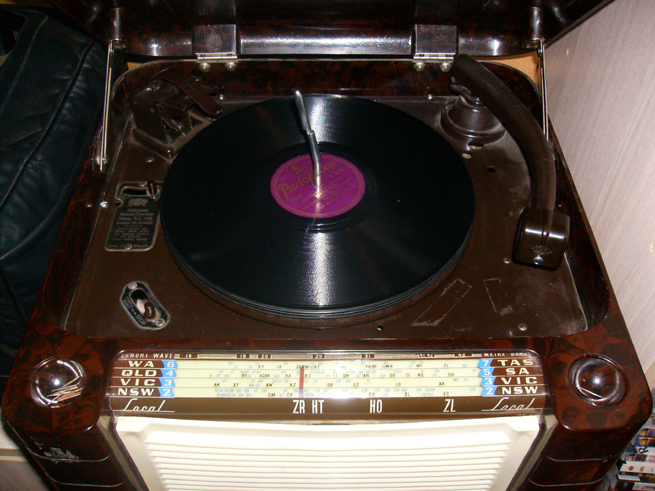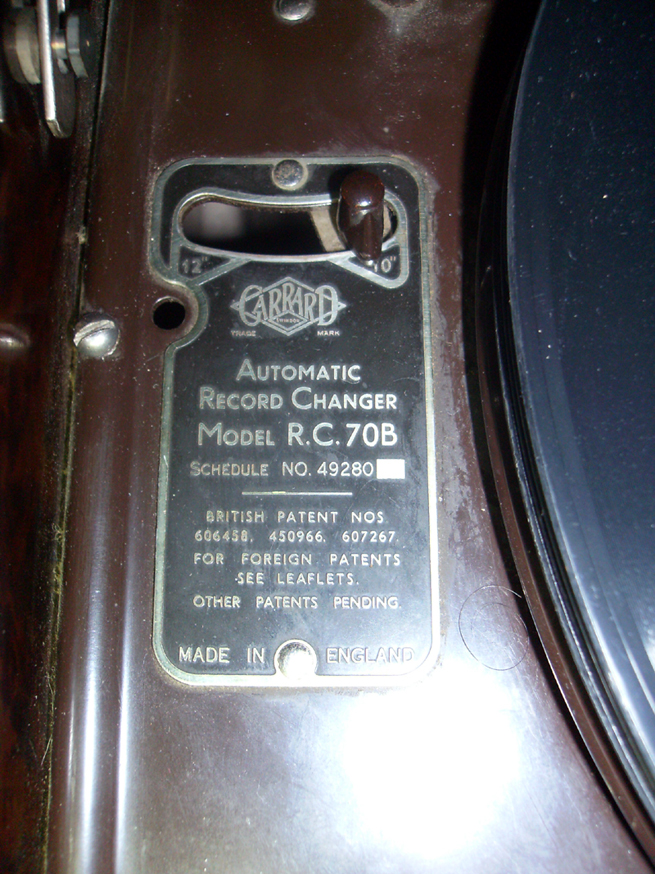Tech Talk
Forum home - Go back to Tech talk
|
Scharnberg Strauss Tablegram
|
|
|
« Back ·
1 ·
Next »
|
|
|
Return to top of page · Post #: 1 · Written at 4:37:53 PM on 11 August 2014.
|
|
|
|
Location: Cameron Park, NSW
Member since 5 November 2010 Member #: 770 Postcount: 409 |
|
I have just completed restoration of this radio/player and have submitted it to Radiomuseum.org as a new model. They correctly pointed out that the 4 speed record changer is about 6 or 7 years later than my player and I would like to know what might have been originally installed. |
|
|
Return to top of page · Post #: 2 · Written at 9:16:49 PM on 13 August 2014.
|
|
|
|
Location: Hobart, TAS
Member since 6 May 2013 Member #: 1337 Postcount: 73 |
|
I have a Precedent tablegram that was made in 1952 by Jackson industries in Melbourne. It still has it's original record changer installed which is a Garrard 78rpm only model. The original grease on the changer mechanism had congealed and hardened so I cleaned off all the old grease and re greased the cams under the changer mechanism and it is working well. |
|
|
Return to top of page · Post #: 3 · Written at 7:10:22 AM on 15 August 2014.
|
|
|
|
Location: Cameron Park, NSW
Member since 5 November 2010 Member #: 770 Postcount: 409 |
|
Thanks, Samt, According to an original advert, a Garrard unit was used so it could be the same one. Any chance of a photo? |
|
|
Return to top of page · Post #: 4 · Written at 8:00:43 PM on 28 August 2014.
|
|
|
|
Location: Hobart, TAS
Member since 6 May 2013 Member #: 1337 Postcount: 73 |
|
Hi Gandhn, sorry about the late reply. I have just moved house and my tablegram was stored at another house while I moved. The record changer on my 1952 Precedent tablegram is a Garrard R.C 70B 78 RPM only. The record changer works well after a clean and re grease. The stepped spindle lifts out and is stored next to the platter when the lid is closed. I have emailed the photos to the administrator to include.   |
|
|
Return to top of page · Post #: 5 · Written at 9:41:39 AM on 29 August 2014.
|
|
|
|
Location: Canberra, ACT
Member since 23 August 2012 Member #: 1208 Postcount: 584 |
|
SamT's changer looks to be very well preserved. It reminds what a problem it was to play any music longer than about 3-4minutes. In those days an "album" was literally a bound volume or box of paper or cardboard envelopes,each containing one disc of the set. |
|
|
Return to top of page · Post #: 6 · Written at 7:24:19 PM on 29 August 2014.
|
|
|
|
Location: Hobart, TAS
Member since 6 May 2013 Member #: 1337 Postcount: 73 |
|
The Automatic Record Changer was invented by a 20 year old Tasmanian Eric Waterworth in 1925. One of his prototype record changers was discovered under his house in Hobart after 60 years and was donated to the Sound Preservation Association of Tasmania. It was re assembled and restored by volunteers and is currently on display at the Sound Preservation Association of Tasmania museum in the old Bellerive post office building in Hobart. It is a facinating place to visit with an excellent collection of radios, phonographs, valves, cinema projection and broadcasting equipment on display. |
|
|
Return to top of page · Post #: 7 · Written at 5:38:15 PM on 31 August 2014.
|
|
|
|
Location: Cameron Park, NSW
Member since 5 November 2010 Member #: 770 Postcount: 409 |
|
Thanks Sam, for your info on the changer. I don't want to change the changer as it will be used for LPs as well as 78s, but I did want to know what was originally installed. The Garrard RC 70B ticks all the boxes. |
|
|
« Back ·
1 ·
Next »
|
|
|
You need to be a member to post comments on this forum.
|
|

Sign In

Vintage Radio and Television is proudly brought to you by an era where things were built with pride and made to last.
DISCLAIMER: Valve radios and televisions contain voltages that can deliver lethal shocks. You should not attempt to work on a valve radio or other electrical appliances unless you know exactly what you are doing and have gained some experience with electronics and working around high voltages. The owner, administrators and staff of Vintage Radio & Television will accept no liability for any damage, injury or loss of life that comes as a result of your use or mis-use of information on this website. Please read our Safety Warning before using this website.
WARNING: Under no circumstances should you ever apply power to a vintage radio, television or other electrical appliance you have acquired without first having it checked and serviced by an experienced person. Also, at no time should any appliance be connected to an electricity supply if the power cord is damaged. If in doubt, do not apply power.
Shintara - Keepin' It Real · VileSilencer - Maintain The Rage
